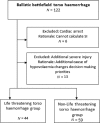Utility of admission physiology in the surgical triage of isolated ballistic battlefield torso trauma
- PMID: 22988401
- PMCID: PMC3440889
- DOI: 10.4103/0974-2700.99690
Utility of admission physiology in the surgical triage of isolated ballistic battlefield torso trauma
Abstract
Background: An assessment of hemodynamic stability is central to surgical decision-making in the management of battlefield ballistic torso trauma (BBTT).
Aims: To analyse the utility of admission physiological parameters in characterising hemodynamic stability.
Settings and design: A retrospective analysis of consecutive admissions, with BBTT, to forward surgical facility in Afghanistan.
Materials and methods: The cohorts' admission physiology, need for operative intervention, and mortality data were collected retrospectively. The cohort was divided into patients requiring surgery for Life-Threatening Torso Hemorrhage (LTTH) and those not requiring immediate surgery (non-LTTH).
Statistical analysis: Parameters were compared using two sample t tests, Mann-Whitney, Fisher's exact, and Chi-square tests. Receiver operator characteristic curves were used to identify significant parameters and determine optimum cut-off values.
Results: A total of 103 patients with isolated BBTT were identified: 44 in the LTTH group and 59 in the non-LTTH group. The mean New Injury Severity Score ± Standard Deviation (NISS±SD) was 28±14 and 13±12, respectively. The heart rate, systolic blood pressure (SBP), pulse pressure, shock index (SI=heart rate/SBP) and base excess were analysed. SI correlated best with the need for surgical torso hemorrhage control, P<0.05. An optimal cut-off of 0.9 was identified, producing a positive and negative predictive value of 81% and 82%, respectively.
Conclusions: Shock index (SI) is a useful parameter for helping military surgeons triage BBTT, identifying patients requiring operative torso hemorrhage control. SI performance requires a normal physiological response to hypovolemia, and thus should always be considered in clinical context.
Keywords: Battlefield torso trauma; shock index; trauma surgery; triage.
Conflict of interest statement
Figures
Similar articles
-
Prediction of Massive Transfusion in Trauma Patients with Shock Index, Modified Shock Index, and Age Shock Index.Int J Environ Res Public Health. 2016 Jul 5;13(7):683. doi: 10.3390/ijerph13070683. Int J Environ Res Public Health. 2016. PMID: 27399737 Free PMC article.
-
Validation of new trauma triage rules for trauma attending response to the emergency department.J Trauma. 2002 Jun;52(6):1153-8; discussion 1158-9. doi: 10.1097/00005373-200206000-00022. J Trauma. 2002. PMID: 12045646
-
Shock Index as a Predictor of Massive Transfusion and Emergency Surgery on the Modern Battlefield.J Surg Res. 2020 Dec;256:112-118. doi: 10.1016/j.jss.2020.06.024. Epub 2020 Jul 16. J Surg Res. 2020. PMID: 32683051
-
Prehospital triage for mass casualty incidents using the META method for early surgical assessment: retrospective validation of a hospital trauma registry.Eur J Trauma Emerg Surg. 2020 Apr;46(2):425-433. doi: 10.1007/s00068-018-1040-6. Epub 2018 Nov 7. Eur J Trauma Emerg Surg. 2020. PMID: 30406394
-
Physiological and medical monitoring for en route care of combat casualties.J Trauma. 2008 Apr;64(4 Suppl):S342-53. doi: 10.1097/TA.0b013e31816c82f4. J Trauma. 2008. PMID: 18385586 Review.
Cited by
-
Effectiveness of clinical examination and radiological investigations in the success of selective non-operative management of abdominal gunshot injuries.Turk J Surg. 2024 Dec 27;40(4):303-311. doi: 10.47717/turkjsurg.2024.6597. eCollection 2024 Dec. Turk J Surg. 2024. PMID: 39980639 Free PMC article.
-
Do patients with penetrating abdominal stab wounds require laparotomy?Arch Trauma Res. 2013 Spring;2(1):21-5. doi: 10.5812/atr.6617. Epub 2013 Jun 1. Arch Trauma Res. 2013. PMID: 24396785 Free PMC article.
References
-
- Como JJ, Bokhari F, Chiu WC, Duane TM, Holevar MR, Tandoh MA, et al. Practice management guidelines for selective nonoperative management of penetrating abdominal trauma. J Trauma. 2010;68:721–33. - PubMed
-
- Morrison JJ, Clasper JC, Gibb I, Midwinter M. Management of penetrating abdominal trauma in the conflict environment: The role of computed tomography scanning. World J Surg. 2011;35:27–33. - PubMed
-
- Wood AM, Trimble K, Louden MA, Jansen J. Selective non-operative management of ballistic abdominal solid organ injury in the deployed military setting. J R Army Med Corps. 2010;156:21–4. - PubMed
-
- Champion HR, Sacco WJ, Copes WS, Gann DS, Gennarelli TA, Flanagan ME. A revision of the trauma score. J Trauma. 1989;29:623–9. - PubMed




